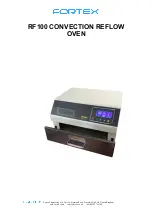
TROUBLE SHOOTING (Cont.)
PROCEDURE
PROBLEM
If 115 volt, check voltage across H1 and H2 terminals of the switch.
If no volt, the switch is defective.
If 115 volt, check for defective solenoid or faulty connection between the load control
and the solenoid.
Step B. Oven Indicator light does not come "ON." This is an indication that the door
switch, flame switches, or the thermostat could be defective. Make sure that the pilot
flame is present. With the load control set at "HI" and thermostat at mid position, carefully
connect a jumper lead across the (2) flame switches. (Connect one side of the lead to
lead No. 35 and the other to lead No. 34 going to the flame switch terminals.)
If the oven indicator light comes "ON" and the solenoid is energized, check for bad
connection to the flame switches or defective flame switches. (The flame switch
contacts must be closed when heated by the pilot flame.)
If the indicator light does not come on, check for bad connection between the master
switch and the thermostat, defective thermostat, or bad connection between the
normally open contact of the door switches and lead No. 34 going to the flame
switches.
3. The oven heats up properly
when empty, but as soon as
as food is put in it, the
temperature drops and the
oven never recovers.
Meals containing excessive moisture can cause the temperature to drop. Also, a cause of
temperature drop is excess load. Refer to the Cooking Chart to insure that the load is of
the recommended capacity of the oven in use.
4. The oven temperature
keeps increasing beyond the
setting of the thermostat.
If the thermostat indicator light cycles on and off, check for defective solenoid.
If the thermostat light remains "ON" check for defective thermostat (contacts welding).
5. The motor turns off and
automatically comes back
"ON" after a few minutes.
The internal thermal protector of the motor is sensing a high temperature which is caused
by:
A. Hi current—Check for clockwise rotation of shaft, for any binding on the shaft or the
blower wheel (the wheel should be rotated freely by a hand touch.) If none of the
above, the motor may be defective.
B. Hi ambient—Check for hot air leakage from inside the oven to the back through the
light or motor housings. Check to see if hot air is blown to the motor from the
adjacent equipment. Check for proper ventilation in the area.
208-240 volt units note:
Sometimes the over current affects the circuit breaker (15 breaker) before it does the
thermal protector; hence, the circuit breaker keeps tripping to "OFF" position.
11
Summary of Contents for RGT-10
Page 21: ...20...
Page 26: ...WIRING DIAGRAM 25...












































